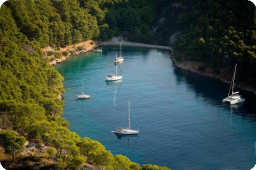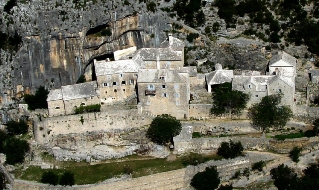

Blaca/island of Brač
Blaca/island of Brač 
When we finally spotted the 500-year-old monastery that was our destination I couldn't believe my eyes. How on earth had anyone managed to create that massive stone structure on a cliff face high in these hostile hills? And, more importantly, how were we going to get there?
It had been tricky enough getting this close because the three monks who founded the monastery in the 16th century - after fleeing from the Croatian mainland in the face of the invading Ottoman Turks - were clearly looking for solitude.
From our base in the town of Bol it had taken an hour-long boat trip along the rugged coast of the island of Brac to reach the lonely bay, with its crude wharf and a burned-out stone shrine, which once held a figure of the Virgin Mary, where the track to the monastery began.
The landscape where we landed was harsh, with more rocks than plants, little sign of water or wildlife, and was made even harsher by a recent fire which had left the few trees standing stark and black against the white of the stone for which Brac is famous.
Fortunately, the monks who built the Blaca monastery knew how to make paths and walls as well as the chapel, school, dormitory, refectory and library they erected over the centuries.
So, while it was a demanding walk up the hills in the warm Adriatic sun, it was mostly along a well-built route made even more civilised by the abandoned cottages and stone livestock pens along the way.
When we panted up the final steep incline to the monastery it was a spectacular sight and well worth the walk.
Sanja, our guide, had told us that the monastery closed following the death of the last superior, Father Niko Milievic back in 1963, but the place seemed occupied.

I had read that it still contained fascinating astronomical equipment, a collection of antique watches and clocks and a library filled with old Cyrillic manuscripts which visitors were sometimes able to see.
But, when I raised this, Sanja explained that the monks who used to return occasionally to show people round had recently stopped coming so we would not be able to get inside.
Still, while the others in our group explored stone water cisterns and the grapevines from which the monks once made their famous wine, I checked if anyone was home.
Just for fun I pulled the rope to ring the entrance bell, knocked on the big wooden door then tried the old metal latch and, to my amazement, it opened.
Cautiously, my wife and I tiptoed inside and found ourselves in a stone courtyard, shaded by an ancient fig tree, and containing what looked like an old wine press, wooden tables and chairs, iron pots, bags of meal and some lovely photos of donkeys, goats and sheep.
The buildings were all locked but it was still quite exciting to wander the stone passages between them, where monks had walked and prayed for so many centuries.
Back outside, we could also explore what had obviously once been extensive gardens. Sanja told us the monks exported wine, olive oil and honey, with the profits used to buy a printing press and run a school for the island's children.
As we made the much easier walk back down to the wharf I reflected that it seemed a pity the monastic way of life - which here at least seemed to have done a lot of good - should have come to an end.
But Blaca Monastery is far from alone in having had to close.
On the boat journey back we saw another huge monastery high on a hillside which Sanja said had closed. And back in Bol, with its colourful fishing boats and waterfront cafes, we found a Dominican monastery which was closed for renovation as a museum. Pity, because it apparently houses a superb Madonna and Child altar painting by the Venetian artist Tintoretto.
Still, at least one tradition turned out to be alive and well. The owner of the boat transporting us down the coast produced a bottle of grappa made from walnuts to revive our tired limbs. It was fiery but delightful.
When I expressed interest in it he produced two more bottles, one made with herbs; another with walnuts, and insisted I try another couple of glasses.
Things are a bit blurred after that but I think he told me the monks at Blaca used to make a mighty fine grappa.
"But this is made by my neighbour. It is very good."
Source: http://www.nzherald.co.nz/
Video
Current news
 Macrocruise charter agency
Additional discount on the boat rental price of betw
Macrocruise charter agency
Additional discount on the boat rental price of betw






















